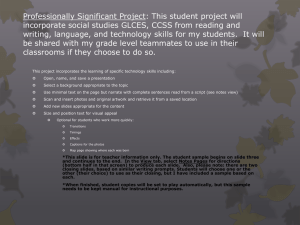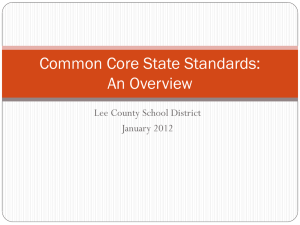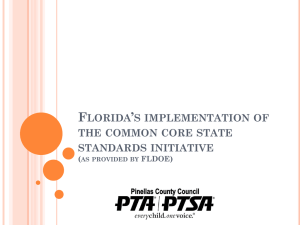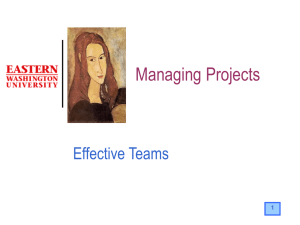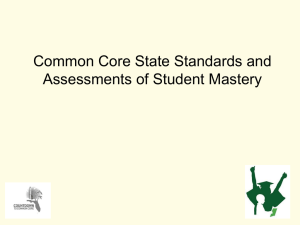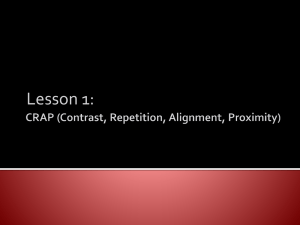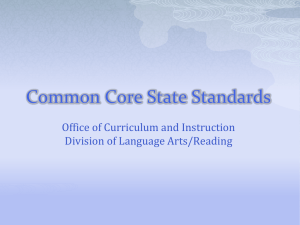CCSS-CTE Task Ailgnment PPT
advertisement
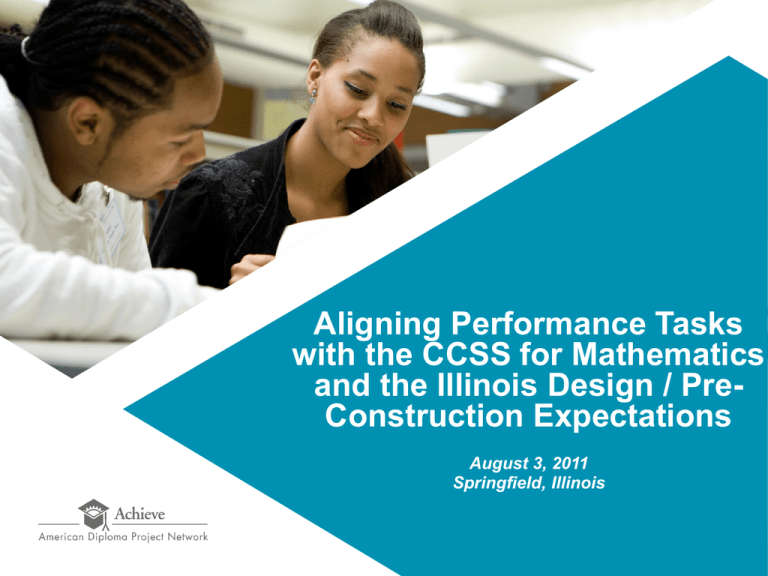
Aligning Performance Tasks with the CCSS for Mathematics and the Illinois Design / PreConstruction Expectations August 3, 2011 Springfield, Illinois Introduction In this presentation we will: Provide an overview of an approach that Achieve has developed with a large urban school district to integrate the CCSS with classroom instruction. Introduce a process for determining alignment of a performance task with the Common Core State Standards (CCSS) and the Illinois Design/PreConstruction expectations. Walk through a performance task to learn how to use this approach. Break into small groups to review/modify tasks supplied by workshop participants. Review and offer feedback on the tasks being modified/developed by other small groups. Discuss the implications of this approach and brainstorm ideas about how you might use and adapt these tools in your district and schools. 2 Components of a High-Quality Instructional Task A High Quality Instructional Task Should: Be based on, and aligned to, standards (in our case, the CCSS for Mathematics and the Knowledge and Skill statements that apply to the Design/PreConstruction pathway) Reflect strong instructional practices Prepare students for college and careers Assess student knowledge and skill across the full performance continuum Support a culture of continuous improvement that can guide good instruction Elicit complex student demonstrations or applications Assess all students, including high and low achieving students and ELL students and students with disabilities 3 Steps for Aligning Mathematics Tasks to the CCSS and the Illinois Design/Pre-Construction Expectations Step 1. Work the task thoroughly. Step 2. Compare your work with the answer key/rubric and other instructional support materials and/or with the work of colleagues. Step 3. Identify the content and performances required to complete the task. Step 4. Compare task performances to the CCSS Standards for Mathematical Practice a) identify and list on the purple recording sheet those Mathematical Practices reflected in the task b) rate the degree of alignment using the 0-3 rating scale provided c) make note of important points concerning alignment between the task and each standard, as appropriate. d) make note of strengths and weaknesses of the task with respect to each standard and ways the alignment of the task to the standards might be improved, as appropriate. 4 Steps for Aligning Mathematics Tasks to the CCSS and the Illinois Design/Pre-Construction Expectations Step 5. Compare task content and performances to the grade-level (grades 6-8) and high school CCSS a) identify and list on the blue recording sheet those CCSS standards reflected in the task b) rate the degree of alignment using the 0-3 rating scale provided c) make note of important points concerning alignment between the task and each standard, as appropriate d) make note of strengths and weaknesses of the task with respect to each standard and ways the alignment of the task to the standards might be improved, as appropriate. 5 Steps for Aligning Mathematics Tasks to the CCSS and the Illinois Design/Pre-Construction Expectations Step 6. Compare task content and performances to the Knowledge and Skills statements that apply to the Design/Pre-Construction pathway a) identify and list on the orange recording sheet those Knowledge and Skill statements reflected in the task. Pay particular attention to the Cluster and Pathway Knowledge and Skill statements, since they provide the greatest level of specificity and detail. b) rate the degree of alignment using the 0-3 rating scale provided c) make note of important points concerning alignment between the task and each Knowledge and Skill statement, as appropriate d) make note of strengths and weaknesses of the task with respect to each Knowledge and Skill statement and ways the alignment of the task to the statements might be improved, as appropriate. 6 What Does This Alignment Process Tell Us? What Are the Next Steps? Is the task, as written, of high quality and well-aligned with the CCSS Standards for Mathematical Practice, CCSS grade-level/high school standards, and the Design/Pre-Construction cluster/pathway Knowledge and Skill statements? If so, it is “ready to go.” Are there ways that the task can be improved to enhance alignment with the relevant standards and better meet the needs of teachers and the range of students they encounter in their classrooms? If so, the task “needs improvement.” Is the task so poorly aligned with the CCSS and the cluster/pathway Knowledge and Skill statements that it is not really usable? If so, discard the task. 7 Common Practice Task 1: Building Construction Step 1: Work task Step 2: Compare solutions Step 3: Identify content and performances 8 Common Practice Task 1: Building Construction Task The Smiths are working with an architect and contractor to finalize their building plans with the dimensions in Figure 4. 1. The building plan calls for a slate roof. The Smith’s request an estimate for shingles. To give an estimate the contractor must calculate the area of the roof. What is the roof’s area? 2. The architect suggests painting the siding to get the color preferred by the Smith’s. She asks the contractor for an estimate of the cost to paint the house. The area to be painted includes the two triangular gable ends. (One of the gables is visible in Figure 4.) The paint covers about 350 square feet per gallon. How many gallons of paint should be included in the estimate if the building will get two coats? 3. If 10% of the building’s four rectangular walls are windows that do not need painting, does the amount of paint needed by the painter decrease? Source: Adapted from ResourceMap, used with permission 9 Common Practice Task 1: Building Construction Solution Source: Adapted from ResourceMap, used with permission 10 Common Practice Task 1: Building Construction Step 4: Compare task performances to the CCSS Standards for Mathematical Practice Which of the Standards for Mathematical Practice align with the requirements of the task? 11 Common Practice Task 1: Building Construction Mathematical Practices aligned with the task: MP.1 Make sense of problems and persevere in solving them MP.2 Reason abstractly and quantitatively MP.4 Model with mathematics MP.6 Attend to precision 12 Rating Scale for Performance 3 = Excellent: The performances of the task are clearly consistent with the performances of the identified standard. 2 = Good: This rating is used for a partial match. Performances addressed in the task are consistent with the most critical performances of the identified standard. However, supporting performances of the standard may not be addressed (possibly by design). 1 = Weak: This rating is used for a partial match when the most critical performances addressed in the identified standard are NOT addressed in the task. However, supporting performances of the standard are addressed. 0 = No Alignment: None of the performances addressed in the task match the performances of the identified standard. (Delete this standard from the list of standards identified as aligned with the task.) 13 Ratings and Alignment Comments for Performance: Building Construction Math Practice MP.1 Make sense of problems and persevere in solving them MP.2 Reason abstractly and quantitatively MP.4 Model with mathematics Performance Rating Alignment Comments 3 Students analyze givens, constraints, relationships, and goals. They must make conjectures about the form and meaning of the solution and plan a solution pathway. They must make sure their answers make sense in the context of the problem. 3 Students make sense of quantities and their relationships in problems situations. They must create a coherent representation of the problem at hand, considering units and attending to the meaning of quantities. 3 Students apply the mathematics they know to solve a workplace problem. They use measurement and geometric knowledge and skills to solve a pre-construction problem. They interpret results in the context of the problem. 3 Students need to calculate accurately and express answers with a degree of precision appropriate for the problem. MP.6 Attend to precision 14 Common Practice Task 1: Building Construction How might this task be rewritten to align even more strongly with the Standards for Mathematical Practice? Students might be presented with dimensions of the house, rather than an image, and asked to sketch a model of the house. Students might be asked to justify or explain their answer to the third part of the question. Students might be asked to prepare a presentation for the client, presenting various cost options based on such things as variations in roofing materials, quality of paint, and different design features desired by the client. 15 Common Practice Task 1: Building Construction Step 5: Compare task content and performances to the grade-level (grades 6-8) and high school CCSS Which of the grade-level and/or high school CCSS align with the requirements of the task? 16 Common Practice Task 1: Building Construction Grade Level / High School Standards aligned with the task: G.MG.1 Use geometric shapes, their measures, and their properties to describe objects 7.G.6 Solve real-world and mathematical problems involving area, volume and surface area of two- and three-dimensional objects composed of triangles, quadrilaterals, polygons, cubes, and right prisms. N.Q.1 Use units as a way to understand problems and to guide the solution of multi-step problems; choose and interpret unites consistently in formulas; choose and interpret the scale and the origin in graphs and data displays. 17 Rating Scale for Content 3 = Excellent: The content of the task is clearly consistent with the content of the identified standard. 2 = Good: This rating is used for a partial match. Content addressed in the task is consistent with the most critical content of the identified standard. However, supporting content of the standard may not be addressed (possibly by design). 1 = Weak: This rating is used for a partial match when the most critical content addressed in the identified standard is NOT addressed in the task. However, supporting content of the standard is addressed. 0 = No Alignment: None of the content addressed in the task matches the content of the identified standard. (Delete this standard from the list of standards identified as aligned with the task.) 18 Ratings and Alignment Comments for Content and Performance: Building Construction CCSS C G.MG.1: Use geometric shapes, their measures, and their properties to 3 describe objects. 7.G.6 Solve real-world and mathematical problems involving area, volume and surface area of two- and three2 dimensional objects composed of triangles, quadrilaterals, polygons, cubes, and right prisms. N.Q.1: Use units as a way to understand problems and to guide the solution of multi-step problems; choose and 2 interpret units consistently in formulas; choose and interpret the scale and the origin in graphs and data displays. P Alignment Comments While area is one way to describe an object, the 2 simple calculation of area is likely not as robust a description as intended by this standard. This task does not call for the determination of 3 volume and deals with simple geometric shapes including triangles and rectangles. While this problem involves the use of units (feet, square feet, gallons), it does not require students to make any choices about units. Choosing and 2 interpreting the scale and origin in graphs and data displays is not addressed. 19 Common Practice Task 1: Building Construction How might this task be rewritten to align even more strongly with the CCSS? The exterior design of the building might be made more complex, perhaps involving the use of multiple types of building materials configured in ways that capitalize on more types of geometric shapes—making area and surface area calculations more robust. Students might be asked to assume the role of an architect and use geometric shapes and their measures to describe options for the design of a building to a client. This task could be made more robust and realistic if students were presented with measurements that required some unit conversion (e.g., if some of the measurements were in feet and inches, students would need to choose which unit to use and how to interpret subsequent solutions). 20 Common Practice Task 1: Building Construction Step 6: Compare task content and performances to the cluster/pathway Knowledge and Skill statements Which of the cluster/pathway Knowledge and Skill statements align with the requirements of the task? 21 Common Practice Task 1: Building Construction CTE cluster/pathway Knowledge and Skill statements aligned with the task: ACC01.01.02 Use geometric figures to determine areas and volumes of various structures. ACC01.01.05 Use appropriate formulas to determine measurements of dimensions, spaces and situations. ACC01.01.06 Conceptualize a three-dimensional form from a two-dimensional drawing to visualize proposed work. ACC03.01.03 Estimate resources/materials required for a specific project or problem. 22 Ratings and Alignment Comments for Content and Performance: Building Construction Cluster/Pathway Knowledge and Skill Statement ACC01.01.02: Use geometric figures to determine areas and volumes of various structures. ACC01.01.05 Use appropriate formulas to determine measurements of dimensions, spaces and situations. ACC01.01.06: Conceptualize a threedimensional form from a twodimensional drawing to visualize proposed work. ACC03.01.03: Estimate resources/materials required for a specific problem. C P Alignment Comments 2 3 This task requires area calculations but not volume calculations. 3 3 3 3 3 3 It is assumed that students are using the formulas for area of a rectangle and area of a triangle to perform the calculations. While conceptualization and visualization may be hard to assess, they are required skills in this task since students need to make sense of the two-dimensional model in order to perform the appropriate calculations. Estimation of the amount of paint needed is addressed in Questions 2 and 3 of this task. 23 Aligning Performance Tasks with the CCSS for Mathematics and the Illinois Design / PreConstruction Expectations August 3, 2011 Springfield, Illinois

